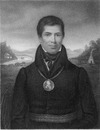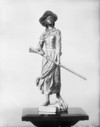was a cadet with the colonial regular troops at Fort Saint-Frédéric (Crown Point, N.Y.) on Lake Champlain. On 23 Oct. 1749, Governor La Jonquière
party of friendly Indians freed these unfortunates in the region of Lake Champlain. The absence of civil records and the silence of the authorities prevent us from knowing how many victims there were
years of age, she was married near Trois-Rivières, at Champlain, to Jacques Aubuchon, by whom she had a daughter. On 3 Nov. 1688 she was married again, this time to Michel
bind you with the most solemn of ties.”
In May 1758 Kisensik set out again for the Lake Champlain frontier, determined “to redden with English
colony at the head of a party of 500 men harassing the British at the portage between Lake Champlain and Lac Saint-Sacrement (Lake George). For the next five years he led a mobile patrol varying between
sur les arts, 95–96; Paul Lambert dit Saint-Paul (Collection Champlain, Québec, 1945). Traquair, Old silver of Quebec. Marius Barbeau, “Deux cents ans d’orfèvrerie chez-nous
. Gérard Morisset, Évolution d’une piéce d’argenterie (Collection Champlain, Québec, 1943), 8–9. Marius Barbeau, “Indian trade silver,” RSCT, 3rd ser., XXXIV (1940), sect
Fort Chambly on the upper Richelieu, then extended down the Richelieu to Fort Saint-Jean where it linked up with a ferry, a flat-bottomed boat built in 1741 to navigate on Lake Champlain as far as Fort
-Madeleine (Laprairie) in 1705, and Pointe-aux-Trembles (Neuville) in 1716. Two former missions were taken over again: Lachine in 1701, and Champlain in 1702. The mission at La Montagne was moved to Sault
LEFEBVRE DUPLESSIS FABER (Fabert), FRANÇOIS, seigneur, officer in the colonial regular troops; b. 9 Nov. 1689 in Champlain
.
During the Seven Years’ War, Langis and his older brother Alexis were employed scouting, taking prisoners, and gathering information on the enemy’s strategy in the Lake Champlain–Lac Saint-Sacrement (Lake
Rigaud* de Vaudreuil as garrison adjutant of New France and took his place on the council of war. At this time he was also given a seigneury on Lake Champlain. This was an eventful year for in October
town; d. 1763 in the Lake Champlain area.
John Lottridge is first mentioned as a second lieutenant in Edmond Mathews’ company of the New York
of Lake Champlain. During that period he supplied material for the first three naval vessels to be built at Quebec, the flutes Canada and Caribou and the frigate Castor. He
Noyan, and left the post the following year with the cross of Saint-Louis. He was granted in 1735 a seigneury on Lake Champlain which he did not develop and therefore forfeited six years later. Finally
Royale (Cape Breton Island), Vaudreuil made plans for an attack on the English bases south of Lake Champlain. Were they to be destroyed the feared invasion by that route would be disrupted. In July, after
.
With the coming of war in 1755 Perrault assigned the men of Deschambault to serve chiefly as bateau crews to convey troops and war materials to Lake Champlain. Military supplies were kept under armed
Hocquart*, the financial commissary, a commission as royal notary for the region covering the seigneuries of Batiscan, Champlain, and Les Grondines. On 24 March 1732 Intendant Hocquart granted
Champlain and Lake Ontario. During the winter of 1755–56, Cressé was sent with a work party to Fort Frontenac (Kingston, Ont.) where he began building two ships, a schooner of ten guns (probably the
also, with Daniel Robertson of Montreal, the subject of a petition to Carleton from Samuel MacKay, deputy surveyor for the navy. MacKay had claimed for the navy 200 trees in the Lake Champlain area, cut







